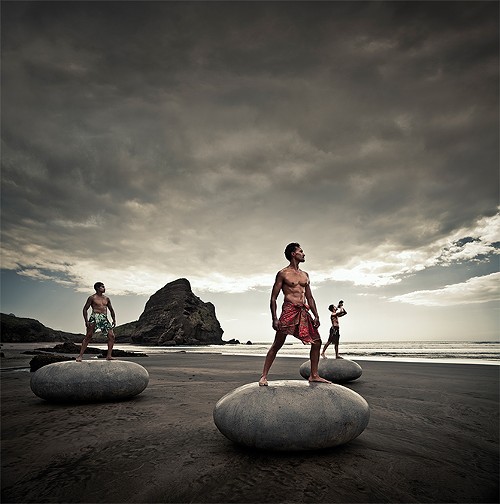Motion of the Ocean
The dancers of Black Grace bring Pacific Islander movement to the world.
By Katherine PioliThe dancing hula girl—with her grass skirt, swiveling hips and flowery lei—is likely the image that first comes to mind (and, for many Utahns, the Haka) when considering dance from Pacific Island cultures. After the Black Grace dancers perform at Kingsbury Hall this week, that definition is likely to expand.
Black Grace, a contemporary dance company from New Zealand under the artistic direction of founder Neil Ieremia, is certainly well steeped in all the techniques of modern dance. But the group's life energy and greatest source of inspiration comes from Pacific movement traditions. The company's unique combination of traditional and modern is changing both what modern dance can be and what Pacific Islander dance is.
Ieremia was born in Cannon's Creek, a working-class factory town on New Zealand's North Island where the majority of residents, including Ieremia, identify as "Pacific peoples"—those whose ancestors hail from islands like Samoa, Tonga, Fiji and others. Cannon's Creek was a tough place, Ieremia recalls, and for young men of Samoan decent like himself, expectations and opportunities were limited. During an interview in 2013 with PRI's The World, he recalled that "in New Zealand, the Pacific Island culture is a minority ... We're normally thought of as unskilled labor, and when you finish high school—if you finish high school—you're either going to go on welfare or get a job in the local factory."
Ieremia neither went on welfare nor took a factory job. He landed a bank job at the age of 17. Two years later, he quit to accept an invitation to train professionally as a dancer at the Auckland Performing Arts School. When he told his parents he was quitting work to follow his passion, his mother cried, he says, and his father shook his head and walked away. But in many ways, following his dream has paid off.
In 1995, following his studies, Ieremia started Black Grace, then an all-male contemporary dance company with strong roots in Samoan dance traditions. "I saw in my community people who were more talented than me who could do a number of things but all ended up in factories on a downward spiral," Ieremia told CriticalDance in 2015. "I wanted, with Black Grace, to provide a platform for young men like me to come and explore a new avenue, things we didn't think were open to us because dance was the domain of Europeans and quite wealthy families."
These days, the group is internationally renowned. They received rock star attention in 2004 during their first performance at Jacob's Pillow, the oldest internationally acclaimed summer dance festival in the United States, and have been well received in cities across the globe. Part of what makes Black Grace so consistently popular is though the company has seen some significant changes—welcoming both women and dancers of non-Pacific Islander heritage into the company—the style of movement remains rooted in a masculine and Pacific Island tradition, movement that is often aggressive, expansive and ritualistic in a way not seen in other modern companies.
Part of the repertoire the company brings to Salt Lake City this week includes Pati Pati (2009), Mother Mother (2013) and Crying Men (2017). Pati Pati is perhaps the most traditional of these works, a "ritualistic dance" with highly structured hand clapping patterns and group formations (reminiscent of some of the dance spirituals performed by the Alvin Ailey Dance Co.). A purely contemporary piece at first glance, Mother Mother—originally choreographed for a music video for the popular New Zealand pop/dub techno band Fat Freddy's Drop—surprises the audience by allowing the female performers to enter into a masculine space as they jump with stiff, straight bodies and pound their chests and arms in rhythmic patterns, movements traditionally performed only by men in Pacific dance. Crying Men, one of Ieremia's newest works, addresses the challenges faced by men in his community. "Filtered through a Pacific lens," explains a company press release, the work plays with the difficult and varied "expectations of what it means to be a 'real man.'"
Black Grace's infusion of modern movement with a masculine tradition grabs the attention of audiences and critics alike. Even The New York Times, whose critics are often difficult to please, found plenty to enjoy during a Black Grace performance in 2004. "Mr. Ieremia works with a somewhat circumscribed vocabulary, communicating a surprising amount through shifting ranks of dancers," wrote one critic, "and through bounding, bouncing motion, sudden falls and rises and leaps that have the artless beauty of fish breaking from the water and soaring into the sky." Black Grace clearly proves that dance—its stories, ideas and modes of expression—is a powerful method of communication and celebration among all nations and all peoples.
More by Katherine Pioli
-
Support Systems
Brine Dance and RDT work together to give showcase opportunities to dancers and choreographers.
- Sep 18, 2019
-
Feminine Mystique
Girl Child explores the trialsand treasures of being a woman.
- May 15, 2019
-
Oquirrh West Revival
A small company re-launches with the help of a big-name choreographer.
- Mar 20, 2019
- More »
Latest in Arts & Entertainment
Readers also liked…
-
New TV for January 2023
Mayfair Witches, Velma, The Last of Us, Poker Face and more premieres
- Jan 4, 2023




